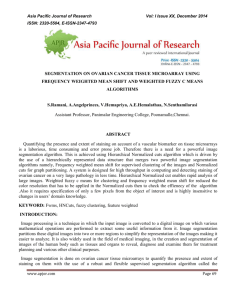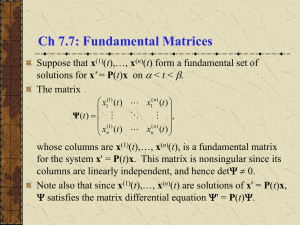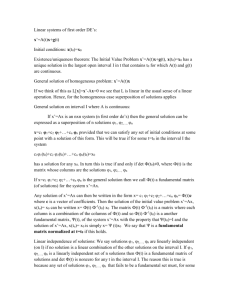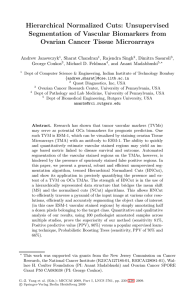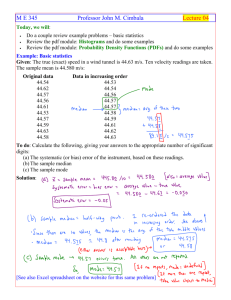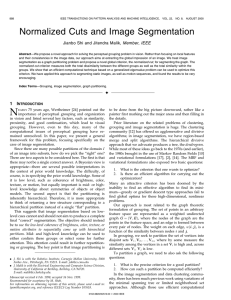ppt
advertisement
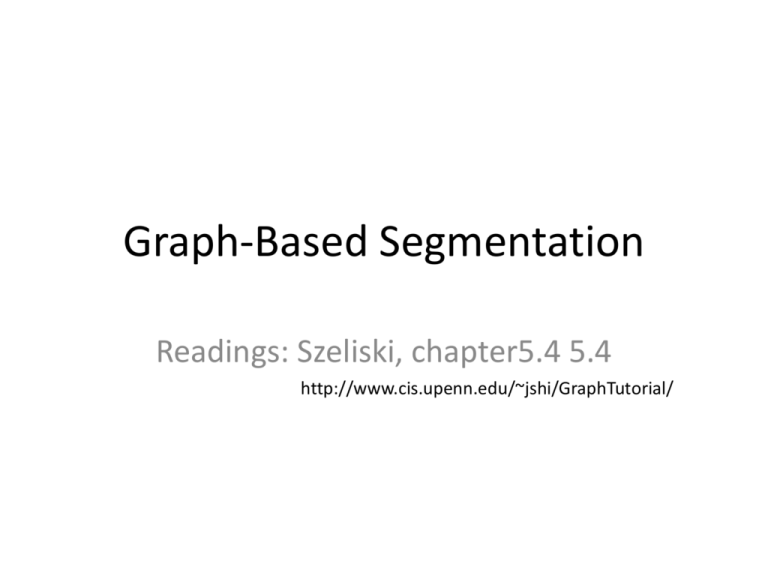
Graph-Based Segmentation
Readings: Szeliski, chapter5.4 5.4
http://www.cis.upenn.edu/~jshi/GraphTutorial/
Image segmentation
• How do you pick the right segmentation?
•Bottom up segmentation:
- Tokens belong together because
they are locally coherent.
•Top down segmentation:
- Tokens grouped because
they lie on the same object.
“Correct” segmentation
• There may not be a single correct answer.
• Partitioning is inherently hierarchical.
• Presentation:
– “Use the low-level coherence of brightness, color,
texture or motion attributes to come up with
partitions”
Affinity (Similarity)
• Pixels in group A and B: high affinities
• Connections between A, B: weak affinity
• Cut
ij
Normalized Cut
• Cut
cut ( A, B)
iA, jB
ij
Using a minimum cut usually involves isolating a single pixel
Normalized Cut
cut ( A, B)
cut ( A, B)
Ncut ( A, B)
assoc( A,V ) assoc( B,V )
Association within a cluster
assoc( A, A)
i , jA
assoc( A,V ) assoc( A, A) cut ( A, B)
ij
Graph-based Image Segmentation
G = {V,E}
V: graph nodes
E: edges connection nodes
Pixels
Pixel similarity
Slides from Jianbo Shi
Graph terminology
• Similarity matrix: W wi , j
X(i ) X( j )
wi , j e
X2
2
2
Slides from Jianbo Shi
Affinity matrix
N pixels
Similarity of image pixels to selected pixel
Brighter means more similar
M pixels
Warning
the size of W is quadratic
with the number
of parameters!
Reshape
N*M pixels
N*M pixels
Graph terminology
• Degree of node:
d i wi , j
j
…
…
Slides from Jianbo Shi
Graph terminology
• Volume of set:
vol( A) di , A V
Association of A
iA
Slides from Jianbo Shi
Graph terminology
Cuts in a graph:
cut ( A, A )
w
iA, jA
i, j
Slides from Jianbo Shi
Representation
segments
Partition matrix X:
Pair-wise similarity matrix W:
pixels
X X1,..., X K
W (i, j ) aff (i, j )
Degree matrix D:
D (i, i ) j wi , j
Laplacian matrix L:
L D W
D=Diag(d)
Pixel similarity functions
Pixel similarity functions
Intensity
I( i ) I( j )
W (i , j ) e
Distance
2
2
I2
X(i ) X( j )
W (i , j ) e
Texture
X2
c( i ) c( j )
W (i , j ) e
c2
2
2
2
2
Pixel similarity functions
Intensity
I( i ) I( j )
W (i , j ) e
I2
W (i , j ) e
X
2
2
here c(x) is a vector of filter outputs.
A natural thing to do is to square the outputs
of a range of different filters
Distance
at different scales and orientations,
2
X(i ) X( j )
smooth the result, and rack
2
these into a vector.
2
Texture
c( i ) c( j )
W (i , j ) e
c2
2
2
Definitions
• Methods that use the spectrum of the affinity
matrix to cluster are known as spectral
clustering.
• Normalized cuts, Average cuts, Average
association make use of the eigenvectors of
the affinity matrix.
• Why these methods work?
Spectral Clustering
Data
Similarities
* Slides from Dan Klein, Sep Kamvar, Chris Manning, Natural Language Group Stanford University
Eigenvectors and blocks
• Block matrices have block eigenvectors:
1= 2
2= 2
1
1
0
0
.71
0
1
1
0
0
.71
0
0
0
1
1
0
.71
0
0
1
1
0
.71
eigensolver
3= 0
4= 0
• Near-block matrices have near-block eigenvectors:
1= 2.02
2= 2.02
3= -0.02
4= -0.02
1
1
.2
0
.71
0
1
1
0
-.2
.69
-.14
.2
0
1
1
.14
.69
0
-.2
1
1
0
.71
eigensolver
* Slides from Dan Klein, Sep Kamvar, Chris Manning, Natural Language Group Stanford University
Spectral Space
Can put items into blocks by eigenvectors:
e1
1
1
.2
0
.71
0
1
1
0
-.2
.69
-.14
.2
0
1
1
.14
.69
0
-.2
1
1
0
.71
e1
e2
Clusters clear regardless of row ordering:
1
.2
1
0
.71
0
.2
1
0
1
.14
.69
1
0
1
-.2
.69
-.14
0
1
-.2
1
0
.71
e1
e2
e2
e1
* Slides from Dan Klein, Sep Kamvar, Chris Manning, Natural Language Group Stanford University
e2
Outline
1. Graph terminology and representation.
2. “Min cuts” and “Normalized cuts”.
How do we extract a good cluster?
• Simplest idea: we want a vector x giving the
association between each element and a cluster
• We want elements within this cluster to, on the
whole, have strong affinity with one another
• We could maximize x TWx
T
• But need the constraint x x 1
• This is an eigenvalue problem - choose the
eigenvector of W with largest eigenvalue.
Minimum cut
Criterion for partition:
min cut ( A, B ) min
A, B
w(u, v)
uA,vB
A
Problem!
Weight of cut is directly proportional to
the number of edges in the cut.
B
Cuts with
lesser weight
than the
ideal cut
Ideal Cut
First proposed by Wu and Leahy
Normalized Cut
Normalized cut or balanced cut:
1
1
Ncut ( A, B) cut ( A, B )
vol( A) vol( B )
Finds better cut
Normalized Cut
• Volume of set (or association):
vol( A) assoc ( A,V ) uA,tV w(u, t )
A
B
Normalized Cut
• Volume of set (or association):
vol( A) assoc ( A,V ) uA,tV w(u, t )
A
B
• Define normalized cut: “a fraction of the total edge connections to
all the nodes in the graph”:
cut ( A, B)
cut ( A, B)
Ncut ( A, B)
assoc( A,V ) assoc( B,V )
A
B
Define normalized association: “how tightly on average nodes
within the cluster are connected to each other”
assoc( A, A) assoc( B, B)
N assoc ( A, B)
assoc( A,V ) assoc( B,V )
A
B
Observations(I)
• Maximizing Nassoc is the same as minimizing
Ncut, since they are related:
Ncut ( A, B) 2 Nassoc ( A, B)
Slides from Jianbo Shi
Slides from Jianbo Shi
Slides from Jianbo Shi
Slides from Jianbo Shi
Slides from Jianbo Shi
Algorithm
• How to minimize Ncut?
– Transform Ncut equation to a matricial form.
– After simplifying:
D (i , i ) j W (i , j )
yT ( D W ) y
min x Ncut( x) min y
T
y
Dy
T
Subject to:
y D1 0
Rayleigh quotient
NP-Hard!
y’s values are quantized
Algorithm
• Instead, relax into the continuous domain by solving
generalized eigenvalue system:
max y yT D W y subject to yT Dy 1
min
• Which gives: ( D W ) y Dy
• Note that ( D W )1 0 so, the first eigenvector is y0=1 with
eigenvalue 0.
• The second smallest eigenvector is the real valued solution to
this problem!!
Algorithm
1. Define a similarity function between 2 nodes. i.e.:
F( i ) F( j )
wi , j e
I2
2
2
X(i ) X( j )
X2
2
2
2. Compute affinity matrix (W) and degree matrix (D).
3. Solve ( D W ) y Dy
4. Use the eigenvector with the second smallest
eigenvalue to bipartition the graph.
5. Decide if re-partition current partitions.
Note: since precision requirements are low, W is very sparse and only few
eigenvectors are required, the eigenvectors can be extracted very fast
using Lanczos algorithm.
Algorithm
Solve
(D - W) y Dy
(I - N ) z z
1
2
N D WD
1
2
1
2
zD y
Normalized affinity matrix, (Weiss 1999)
Discretization
•
Sometimes there is not a clear threshold to binarize since
eigenvectors take on continuous values.
•
How to choose the splitting point?
a)
b)
c)
Pick a constant value (0, or 0.5).
Pick the median value as splitting point.
Look for the splitting point that has the minimum Ncut value:
1.
2.
3.
Choose n possible splitting points.
Compute Ncut value.
Pick minimum.
Use k-eigenvectors
•
•
Recursive 2-way Ncut is slow.
We can use more eigenvectors to re-partition the graph, however:
–
•
Not all eigenvectors are useful for partition (degree of smoothness).
Procedure: compute k-means with a high k. Then follow one of these
procedures:
a)
b)
Merge segments that minimize k-way Ncut criterion.
Use the k segments and find the partitions there using exhaustive search.
e1
•
1
1
.2
0
.71
0
1
1
0
-.2
.69
-.14
.2
0
1
1
.14
.69
0
-.2
1
1
0
.71
e1
e2
Compute Q (next slides).
e2
Toy examples
Images from Matthew Brand (TR-2002-42)
Example (I)
Eigenvectors
Segments
Example (II)
Segments
Original
* Slide from Khurram Hassan-Shafique CAP5415 Computer Vision 2003
Example (III)
Comparative segmentation results (Alpert, Galun, Basri et al. 2007)
probabilistic bottom-up merging
Segmentation Methods Using
Eigenvectors
1. Graph terminology and representation.
2. “Min cuts” and “Normalized cuts”.
3. Other segmentation methods using
eigenvectors.
Other Methods
• Average association
– Use the eigenvector of W associated to the biggest
eigenvalue for partitioning.
– Tries to maximize:
assoc ( A, A) assoc( B, B)
A
B
A
– Has a bias to find tight clusters. Useful for
gaussian distributions.
B
Other Methods
• Average cut
– Tries to minimize:
cut ( A, B) cut ( A, B)
A
B
– Very similar to normalized cuts.
– We cannot ensure that partitions will have a tight
within-group similarity since this equation does
not have the nice properties of the equation of
normalized cuts.
Other Methods
Other Methods
Normalized cut
Average cut
20 points are randomly distributed from 0.0 to 0.5
12 points are randomly distributed from 0.65 to 1.0
Average association
Other Methods
Data
W
First ev
Second ev
• Scott and Longuet-Higgins (1990).
–
–
–
–
V contains the first k eigenvectors of W.
Normalize V by rows.
Compute Q=VTV
Values close to 1 belong to the same cluster.
Q
Other Applications
Data
M
Q
• Costeira and Kanade (1995).
– Used to segment points in motion.
– Compute M=(XY).
– The affinity matrix W is compute as W=MTM. This trick computes
the affinity of every pair of points as a inner product.
– Compute Q=VTV
– Values close to 1 belong to the same cluster.
Other Applications
• Face clustering in
meetings.
– Grab faces from video in
real time (use a face
detector + face tracker).
– Compare all faces using a
distance metric (i.e.
projection error into
representative basis).
– Use normalized cuts to
find best clustering.
Conclusions
• Good news:
– Simple and powerful methods to segment images.
– Flexible and easy to apply to other clustering problems.
• Bad news:
– High memory requirements (use sparse matrices).
– Slow --- multi-grid, hierarchical
– Very dependant on the scale factor for a specific problem.
X(i ) X( j )
W (i , j ) e
X2
2
2
5.5 Graph Cuts and Energy-based
Methods
http://research.microsoft.com/enus/um/cambridge/projects/visionimagevideoediting/segmentation/grabcut.htm
